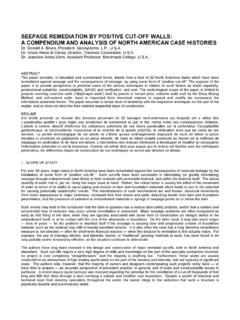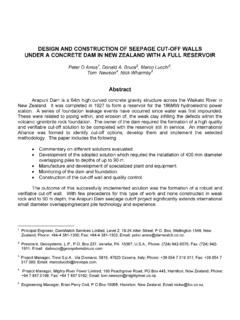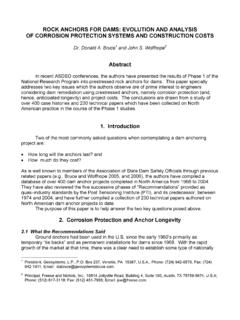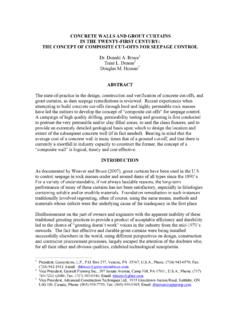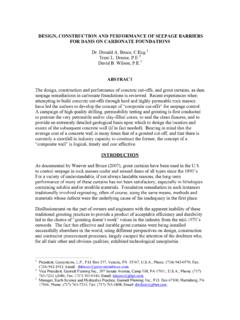Transcription of Cutoff Walls for Dams and Levees - …
1 1 Cutoff Walls for dams and Levees Donald A. Bruce, Geosystems, During the last 10 years, there have been unprecedented levels of activity in the field of dam and levee remediation in the United States. This is reflective of the deterioration of the nation s infrastructure, and also the widespread application of Risk Based Analyses to efficiently identify and prioritize high risk structures and the need to remediate them with urgency. This process has been especially prevalent since the aftermath of Hurricanes Katrina and Rita in the Fall of 2005.
2 The paper describes the current state of practice in the use of the following specialty construction techniques: drilling and grouting; Category 1 Cutoff Walls (excavate and replace); Category 2 Structures (mix in-situ); and rock anchors. Keywords: cutoffs, dams and Levees , deep mixing, diaphragm Walls , materials, secant piles. 1. Introduction The National Inventory of dams (NID) has, to date, listed over 84,000 dams in the United States which meet its criteria for inclusion, namely (Ragon, 2011): 1. High hazard classification loss of one human life is likely if the dam fails.
3 2. Significant hazard classification possible loss of human life and likely significant property or environmental destruction. 3. Low hazard classification no probable loss of human life and low economic and/or environmental losses, but the dam: Equals or exceeds 8 m in height and exceed 15 acre-feet in storage; Equals or exceeds 50 acre-feet storage and exceeds m in height. Almost 14,000 dams meet Criterion 1. Only 4% (3,075) are federally owned, and these mainly date from the earlier third of the Twentieth Century.
4 Over 87% of the total are primarily classified as earth embankments, while no other category exceeds 3% of the total. The main primary purposes are recreation (35%), flood control (17%), fire protection in stock/small fish pond (15%) and irrigation (10%), while less than 3% generate power. Many structures are multipurpose. Figure 1 summarizes their completion dates: about 50% were completed between 1950 and 1979, while the median age in the year 2013 is about 62 years. Figure 1: dams by completion date. (From National Inventory of dams , CorpsMAP, , 2010.)
5 2 Whereas it may be calculated from the National Inventory of dams (2010) that the cumulative end-to-end length of all the dams is around 26,000 km, preliminary estimates put the cumulative length of Levees in the at over 180,000 km. Only about 14% of this total may be regarded as federal, and referred to by Halpin (2010) as robust. The balance includes municipal, local and agricultural structures often having had little formal design, patchwork construction and minimal periodic maintenance, since they were traditionally regarded as simple structures.
6 Certain design assumptions and construction techniques used in the dams and Levees built prior to, say, 1960, would not be acceptable today, and have left behind fundamental flaws in some structures. Appropriate filter criteria for embankments and uplift/sliding issues in concrete dams are two obvious design related examples, while old approaches to rock surface preparation and foundation treatment would also fall into the unacceptable category. In addition, there are two overriding geological considerations which directly influence the serviceability, reliability, and performance of the dam and levee system.
7 These considerations are (i) the presence of solution susceptible carbonate and evaporite formations, and (ii) the potential for seismic activity. Regarding point (i), there is a huge swath of karstic limestone and dolomite which outcrops from Pennsylvania to Alabama, while Martinez, et al. (1998) have estimated that evaporites underly about 40% of the contiguous 48 states. Regarding point (ii), there are highly seismic active zones centered on New Madrid, MO, and Charleston, SC, as well as the more famous organic belts of the Western Very simplistically, therefore, geology and seismicity either alone or together pose a clear and present threat to tens of thousands of water-retention structures nationwide, but especially to those in the basins of the central Mississippi-Missouri river system and its major tributaries such as the Tennessee and Ohio rivers.
8 And to those in the environs of the greater Rocky Mountain chain. To these concerns must be added the more transient, but equally destructive, threat posed by extreme weather events to Levees all across the country, but especially in the upper Midwest, the lower Mississippi, and central California. The problem in the New Orleans area is exacerbated by the continual regional settlement of the entire delta area, estimated at 2 to 12 mm per year. Galvanized by the Gulf Coast tragedy of August, 2005, the federal government, in the form of the USACE ( Army Corps of Engineers), developed and implemented a radically different approach to dam-remediation prioritization, building on the pioneering expertise and experience from the Bureau of Reclamation.
9 This risk-based or risk-informed approach has since become a model for other bodies with large portfolios of dams , including the Tennessee Valley Authority and the larger utilities. This new approach has been the catalyst for the expedited repair of many major structures in recent years, the subject of this paper, although, of course, dam remediation in some form has been around since dam construction. 2. Drilling and grouting Until the mid-1990 s, rock grouting in the was technologically far behind practices employed in many other parts of the world, and especially in France, Germany, Italy and Switzerland.
10 There were many reasons for this, arguably the strongest being (i) the widespread application of very prescriptive specifications (often first developed in the 1930 s) and the associated low bid environment, and (ii) the option, in such a large country, to walk away from a proposed site rather than deal with particularly difficult geological challenges. Recent triggers for innovation include (i) a strong influence from foreign consultants and contractors, (ii) the challenge to remediate projects in-situ ( , no walk away option), and (iii) rapid developments in grouting materials and automated monitoring and control.
